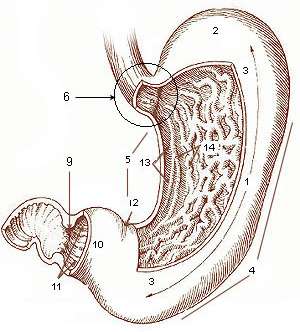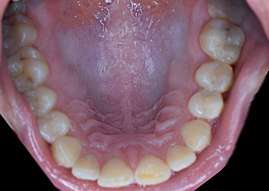Ruga (anatomy)
In anatomy, rugae are a series of ridges produced by folding of the wall of an organ.[1] Most commonly rugae refers to the gastric rugae of the internal surface of the stomach.
| Rugae | |
|---|---|
 Diagram from cancer.gov: Rugae can be seen within stomach. | |
| Anatomical terminology |

Rugae folds behind the anterior teeth in the hard palate of the mouth
Function
The purpose of the gastric rugae is to allow for expansion of the stomach after the consumption of foods and liquids.
Location
Rugae can appear in the following locations in humans:
- Wrinkles of the scrotum
- Hard palate immediately behind the upper anterior teeth
- Inside the urinary bladder
- Vagina
- Gallbladder
- Inside the stomach
Difference between rugae and intestinal villi
Rugae are only evident when an organ or tissue is deflated or relaxed. For example, rugae are evident within the stomach when it is deflated. However, when the stomach distends, the rugae unfold to allow for the increase in volume. On the other hand, plicae remain folded regardless of distension as is evident within the plicae of the small intestine walls.
gollark: At best you can sell low-priced stuff to the owners of megashops.
gollark: It's hard due to sheer inequality.
gollark: Check the economicon?
gollark: There are still richer people.
gollark: Ah, that's how people are ridiculously rich.
References
- Moore, Keith L & Dalley, Arthur F (2006). Clinically Orientated Anatomy (5 ed.). Philadelphia: Lippincott Williams & Wilkins. p. 250.
This article is issued from Wikipedia. The text is licensed under Creative Commons - Attribution - Sharealike. Additional terms may apply for the media files.